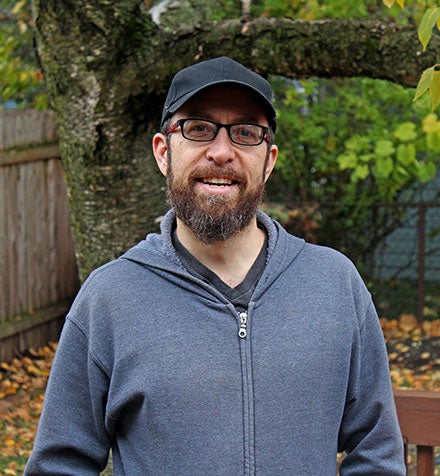Life in 1,000 words
by Kate Frentzel
When people imagine getting care at a VA hospital, they don’t think of getting a biography written. But that’s the gift that Seth Jovaag ’98 and others give patients through the My Life, My Story program. The gift is more than just a meaningful written account—it also goes in the patient’s medical file, and evidence suggests this can lead to better care.

Seth Jovaag '98
The basic protocol for My Life, My Story is this: A writer knocks on a patient’s door, introduces themself and the program, and asks if the patient wants to talk about their life for an hour. Afterward, the writer creates a first-person, 1,000-word story that gets at the heart of what the patient shared. That story is read back to the patient, and a copy is put into their medical file.
My Life, My Story was the brainchild of Elliot Lee, a medical resident on rotation at the William S. Middleton Memorial Veterans Hospital in Madison, Wis. Local poet Thor Ringler got the project off the ground in 2013. After seeing its booth at an oral history conference, Jovaag, a journalist for Wisconsin Public Radio and other outlets, joined the team in 2015. Not having many military connections himself, at first he was skeptical about getting involved. Reading a few sample stories changed his mind.
Jovaag was blown away by their depth and profundity. “People tell you very different things in this situation,” he says. “They’re in a vulnerable place in their life—they’re in a hospital room. And probably in a reflective place too—they’re sick or something. Some of them really grasp onto this idea—this is my chance to talk to somebody and have them write my life down, and I want to tell them what matters most to me.”
The first six times Jovaag read a story back to a patient, they cried, which isn’t uncommon. “People often talk about really meaningful things and tell us things they never told anybody, including their families,” he says. “These are not all war stories.”
But catharsis is a fringe benefit of the project; its true intent is to help healthcare workers better understand and connect with their patients, and thus provide better care. This isn’t just wishful thinking—many studies correlate doctors’ empathy levels with improved patient outcomes. In one, just looking at a photograph of a patient alongside imaging results led to radiologists performing a more thorough reading of the scans.
At the Madison VA, where Jovaag works, 85 percent of clinicians agree that reading the stories is a good use of clinical time. Nursing teams read one at the beginning of their monthly meetings to recenter them on their mission. So do administrative staff. Presurgery teams read about a patient they’ll be treating in order to ease his or her nerves when they arrive. One retiring psychiatrist referred all his patients to the program so that their new doctors would get a sense of their new patients and be able to provide better continuity of care. And sometimes, when there’s a patient on the floor whose personality demands a lot of time and attention, the My Life, My Story team acts as a relief valve. Afterward, the care team might better understand what’s behind the patient’s behavior.

Season 1 of the VA Presents: My Life, My Story podcast is available on Spotify.
Now in its seventh year, the My Life, My Story program has spread to more than 50 VA hospitals across the country. It has captured the stories of more than 5,000 veterans. And this fall, Jovaag, with his background in audio production, launched a podcast sharing some of these veterans’ stories (with their permission). The first season features a 108-year-old veteran, prisoners of war, and a survivor of military sexual trauma. But, like Jovaag says, these aren’t all war stories. They’re stories of love, loss, defining moments, regret, and opportunity—and all the many other things, good and bad, that make a life.
Season 1 of the VA Presents: My Life, My Story podcast is available on Spotify.